An Implementation Plan is a documentation of the steps taken by a company or organization to execute a strategic plan.
The plan breaks down the strategic plan into smaller, specific steps. This plan is, in some cases, referred to as a strategic plan. Fundamentally, it is a combination of the strategy, process, and action to be taken by a team to achieve a common goal. It outlines the resources needed to fulfill the set-out objectives and the resources needed within the execution timeline of the strategic plan.
This plan also interprets abstract ideas, concepts, designs, or policies into actionable steps that the executors of the plan can perform. Plans for implementation are popularly designed for new businesses (start-ups), forthcoming projects or initiatives in an organization, and as guides for actionable business decisions.
note
Typically, an implementation plan will be presented as a written document. Alternatively, it is inserted in a project management solution which is the most preferred method.
This is because it will generally provide solutions or answers to the tasks and subtasks, budget, timeline, collaborators, and additional resources needed for a particular action plan.
Download Free Templates
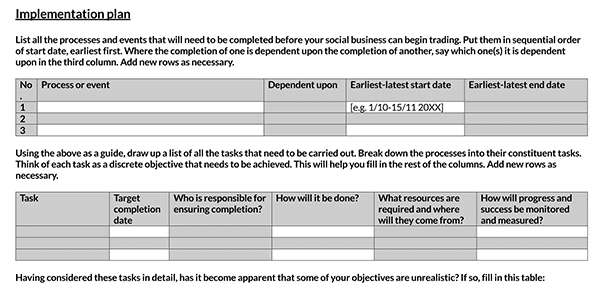
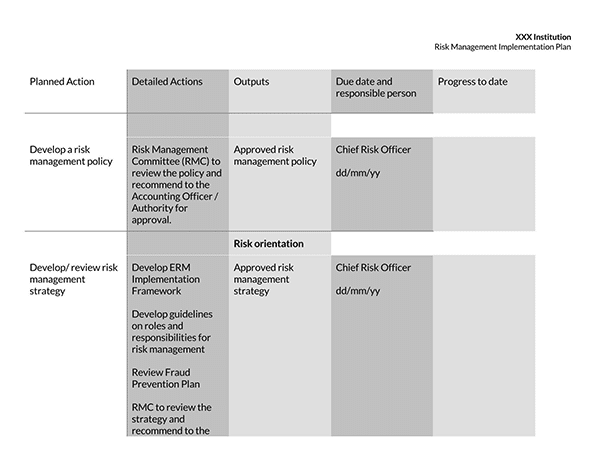
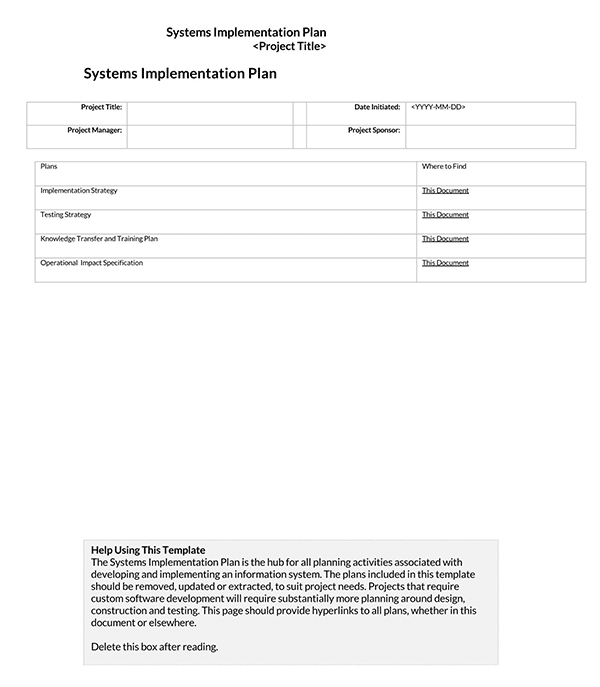
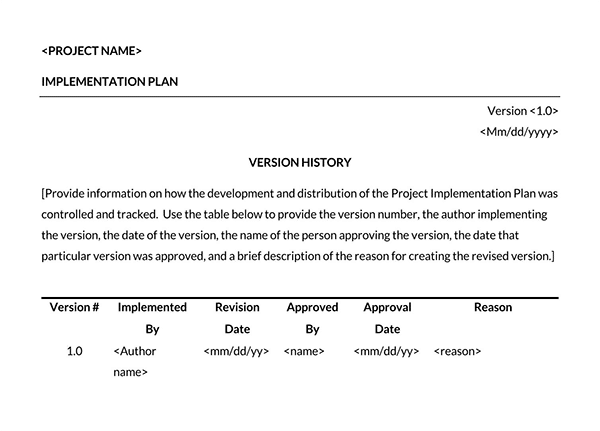
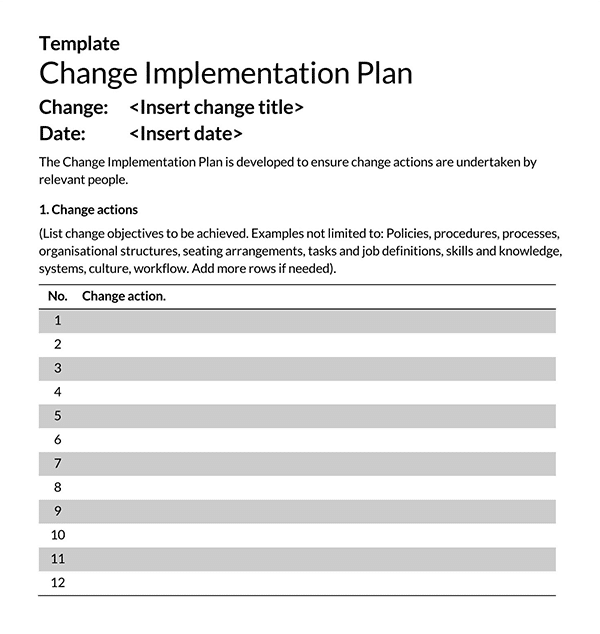
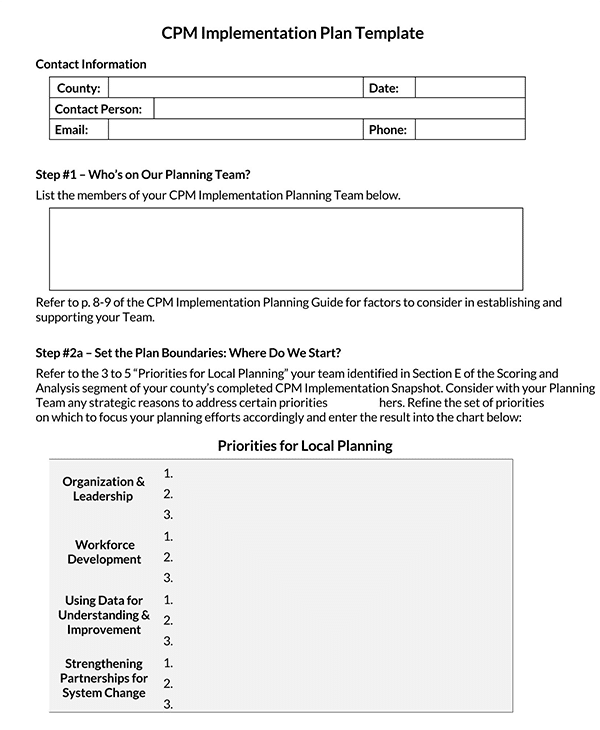
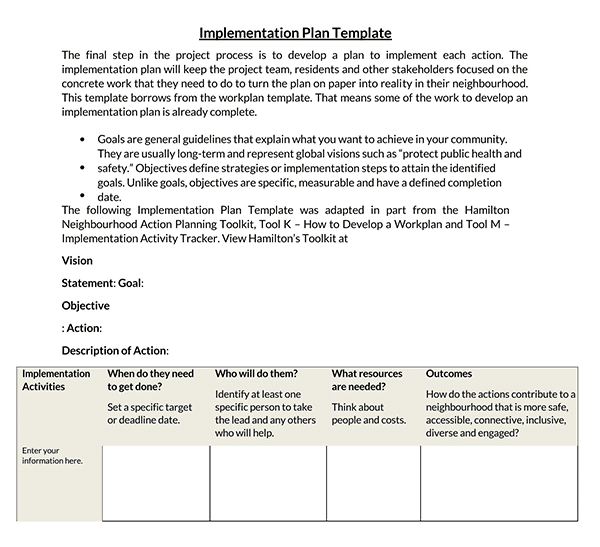
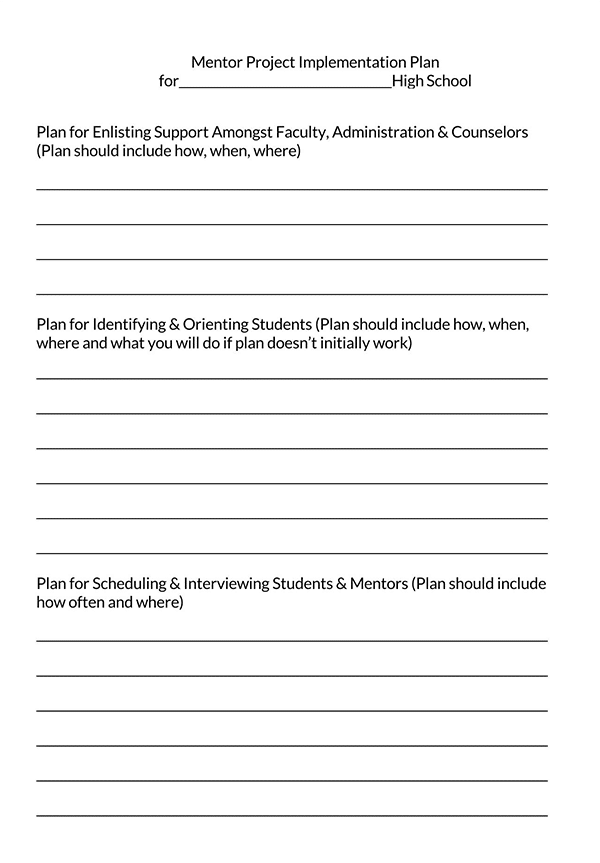
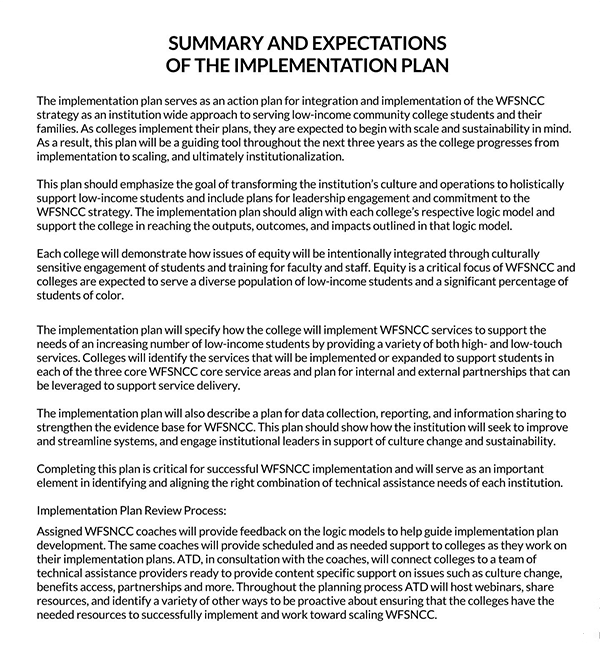
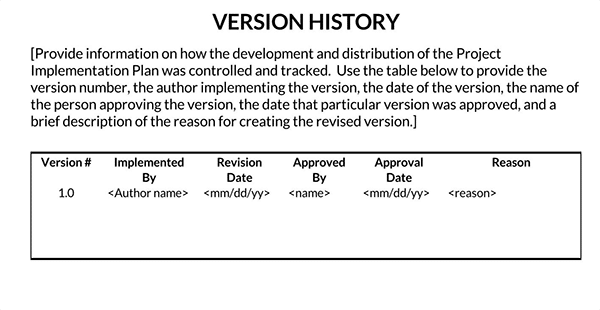
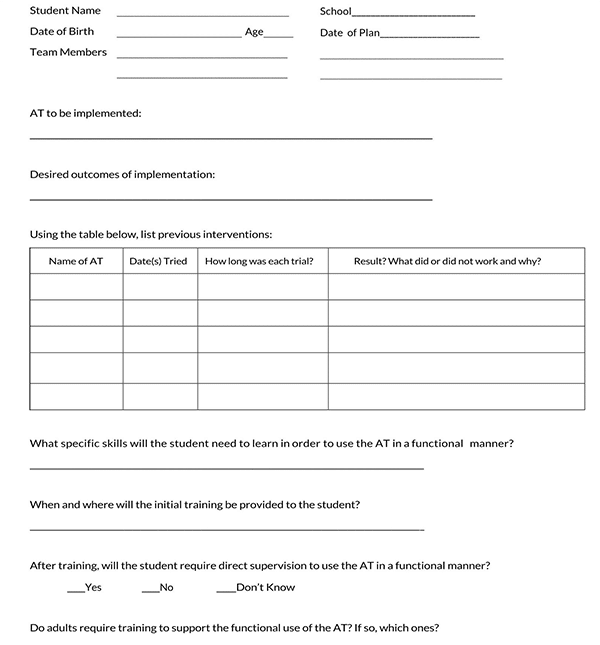
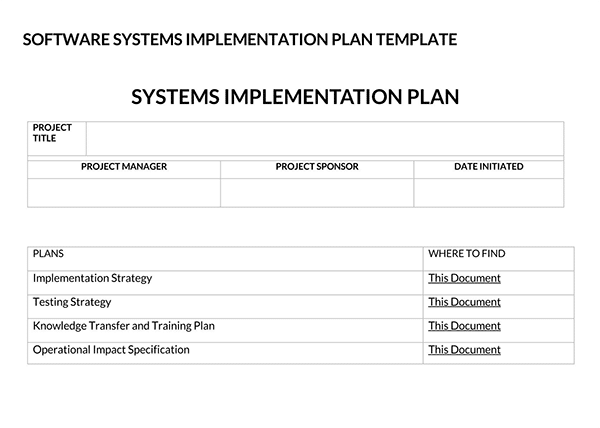
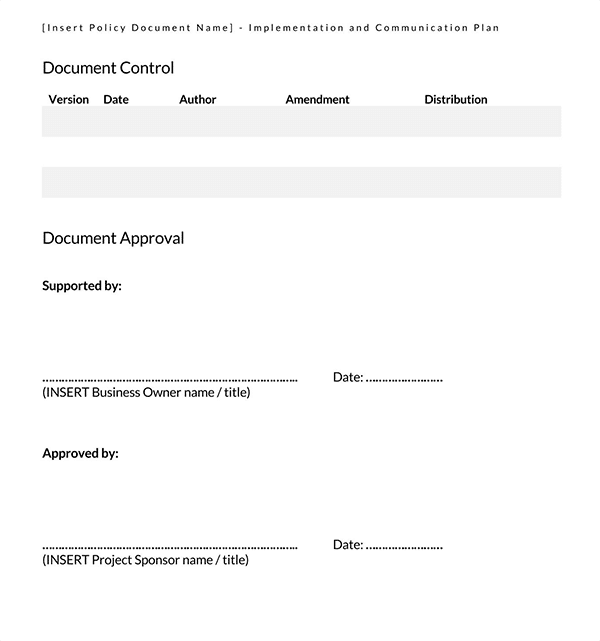
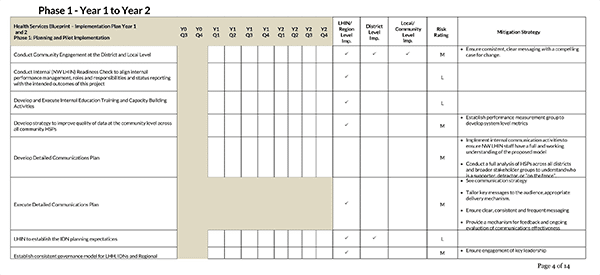
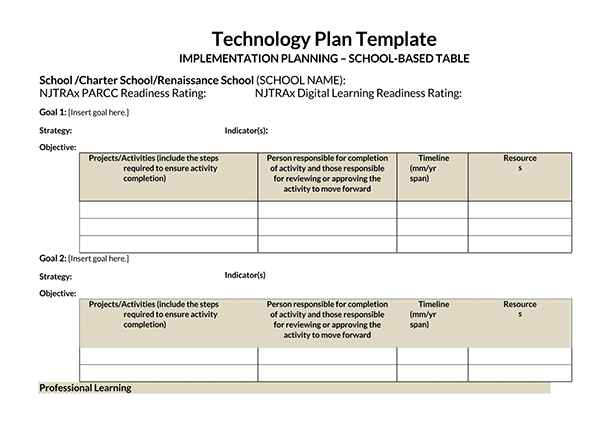
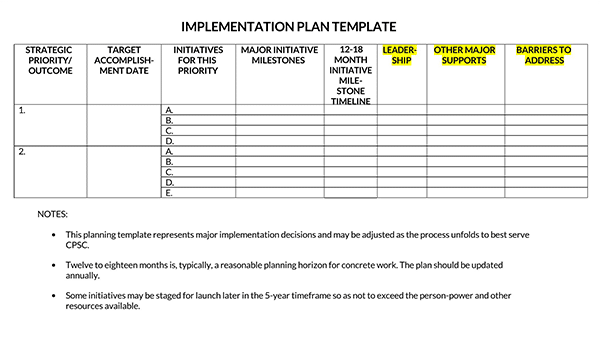
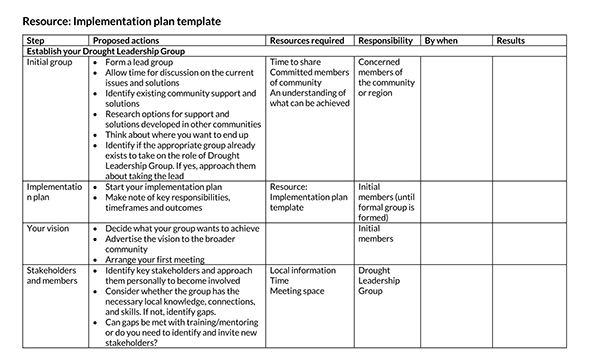
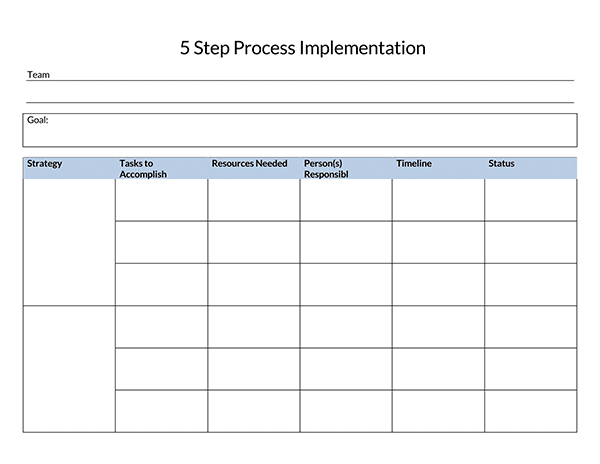
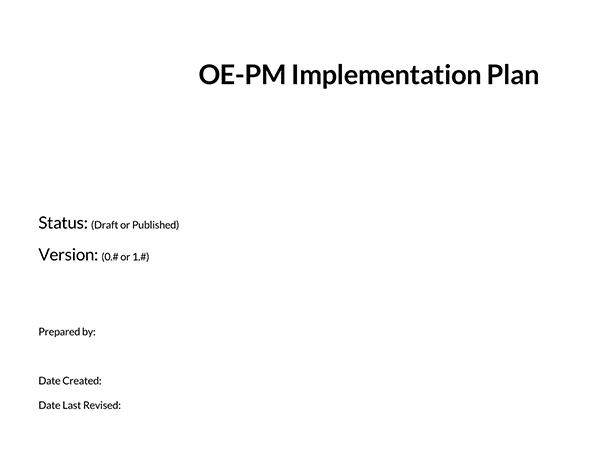
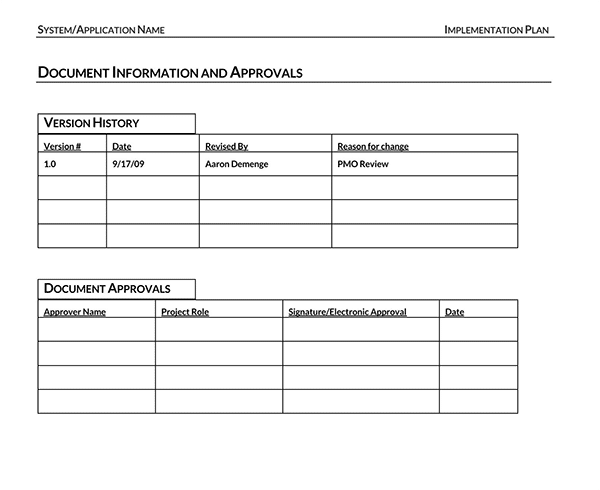
Components of Implementation Plan
This template will typically have the essential components necessary to craft a conclusive plan of implementation.
The following are some of the fundamental components that should appear in the plan:
Outline goals
The first item of a plan of implementation is the goals and objectives of the plan. The goals and objectives represent what the organization intends to achieve with the plan. Each goal and objective should be defined and relevant to the project and the overall organization’s vision and mission.
Assign responsibilities
The primary tasks, actions, and targets involved in the project should be listed, and the responsible parties should be identified. The responsibilities ought to be clearly defined to avoid misinterpretations and mix-ups during execution.
Implementation schedule
An implementation schedule that highlights when each action item should be completed should appear in the this plan. Implementation schedules help keep track of the progress and status of each goal and objective of the plan.
EXAMPLE
The schedule can be a list of task orders and predicted project phases’ timeline.
Resource allocation
All the resources (tools, consumables, and human resources) needed to complete the outlined tasks should be defined and allocated to appropriate tasks and support resources.
EXAMPLE
Facilities, hardware or software tools, workers, contractors, etc.
Define metrics
For a plan to be termed as successfully executed, there must be a way to measure its completion or success/failure. Success will generally be determined with KPIs (Key Performance Indicators). These criteria of measurement are also used in monitoring progress and defining milestones in a project.
Contingency plan
It is advisable to plan for setbacks during project execution. This plan is termed a contingency plan. Several scenarios for which one can create contingency plans are insufficient resources, unprecedented climate, bloat in the budget, and delays in the schedule.
How to Create an Implementation Plan?
The steps involved in crafting this plan are uniform regardless of the project at hand. However, the plan’s creation will ordinarily involve plenty of research and preparation to capture the needed information accurately and adequately.
Below is a step-by-step guide of this process that can be used to develop a professionally prepared plan:
Step 1: Choose an implementation tool
Choose a tool for creating the plan. There are different tools such as Excel and other platforms that can be used to create these plans of implementation. Choose a tool that will best meet the project’s requirements and scope.
Step 2: Scope assessment
Next, define the scope of the plan. Some projects will have broader scopes than others. Clearly define the scope by outlining the purpose, vision, mission, and overall background information of the project or initiative.
Step 3: Review and research
Gather the necessary information required to come up with a satisfactory plan of implementation. This involves extensive research and reviewing of associated documentation of the project.
The following steps can be taken to this effect:
- Brainstorm your desired outcomes: Carefully think of the desired outcome(s) of the project. This will often require a lot of brainstorming. Next, define the outcomes by identifying who the project or initiative benefits, how the benefits will be realized and what will define the end goals that have been successfully achieved.
TIP
Base the outcomes on the best possible scenarios and consider challenges and variations that can influence the end goals.
- Research and discover: Research on the processes, materials, and human resources needed to actualize the plan, i.e., the requirements. Research who is best suited to do what, what resources they will need, and how long it will take to complete the assigned task(s).
- This information can be obtained through interviews with stakeholders, clients, suppliers, experts, contractors, team members, and a review of case studies. Identify primary requirements and secondary requirements so that the plan can be as efficient as possible.
- Review the strategic plan: A good plan of implementation will always track back to the strategic plan. Review the strategic plan and assess if the plan of implementation aligns with it.
- Identify discrepancies and edit the plan of implementation accordingly to support the strategic plan. In such a case, the strategic plan should NOT be adjusted to fit the implementation plan.
Step 4: Create an outline
If the plan of implementation and the strategic plan are in sync, create an outline of the entire plan of implementation highlighting all its components.
The outline can be created with the following steps:
- Write a summary: Craft a summary of the entire plan. Identify the project’s importance, participants, roles and responsibilities, goals and objectives, potential challenges, and metrics for measuring success.
- Map out assumptions and risks: With the draft in hand, identify all factors that might affect the execution of the plan. Assumptions and risks are placed on variables that are capable of changing throughout the project cycle.
- Assign the implementation responsibilities to an owner: Next, choose the overall team leader. The team leader oversees the execution of the entire plan and must delegate responsibilities to team members accordingly.They are expected to report on the progress of the plan. Some desirable traits of a great leader are good communication skills and innovative thinker.
- Outline of deliverables: Identify the actionable goals and outline them as tasks or activities. Tasks are the deliverables of an implementation plan. Clearly define each task.To identify the needed tasks, first, identify the steps and milestones of the project, identify the activities needed to fulfill those steps and milestones, the requirements and parties required to complete those tasks.
Step 5: Establish a budget
Once all the tasks involved in the plan have been identified and defined, determine the associated budget of the project or initiative. Proper budgeting is vital to the success of the implementation.
The proposed budget should cover all the project’s requirements in a scenario where the desired outcome is achieved. In addition, a well-prepared budget will cover the contingencies or miscellaneous costs.
Step 6: Resource allocation
The next step is to allocate them to the appropriate tasks. Common resources needed for organizational projects are money, people, time, equipment, software, support services, etc.
Allocation of resources is done in the following steps:
- Determine activities and define all resources: Firstly, list all the activities and outline related resources. Then, ensure that all resources needed are captured.
- Collect related material: Collect all relevant documentation needed to prepare the plan of implementation. This will usually include reports, departmental budgets, past projects reports, etc.
- Create your implementation task: An action-oriented plan should then be created. The plan should highlight all the information already collected during the development stages
Step 7: Implementation schedule
Next, craft the implementation schedule. The schedule should have a beginning, middle, and end.
The implementation schedule should be created in the following steps:
- Tasks due dates: Use past project reports or industry standards to estimate timelines required to complete project tasks. Breaks the project into milestones and assign deadlines to the milestones.
- Develop implementation schedule: The beginning will outline the setting up, delegation, formalities, etc., and the middle highlights execution actions while the end outlines assessments and quality control procedures.
- Define how progress will be measured: Then define how progress will be monitored. Outline the predetermined KPIs. The KPIs must be aligned with the deliverables. Also, indicate how often monitoring will be conducted.
- Outline management buy-in criteria: Next, outline the key deliverables and selling points that management and stakeholders will be looking for to approve or reject the project. Include additional details that can reduce resistance.
- Stakeholder analysis: Conduct a stakeholder analysis and define the level of impact, attitude, and influence each stakeholder has on the project.
- Clarify day-to-day operations: To conclude the implementation schedule, clarify day-to-day operations by creating a feasible work plan. Indicate the processes and state those that can be changed and how the changes will be handled by designating the responsibility of managing, approving, and finalizing changes to the work plan to a specific individual.
Step 8: Define metrics
Once the implementation schedule is completed, the metrics that track how effectively the plan is executed should be defined.
- Stakeholder, team, and process management plan: Outline metrics that are used on every level of the implementation plan. Describe what defines the team’s success and how the success and progress of each process will be measured.
- Identify project phases, tasks, and subtasks: Break down the entire plan into specific phases, tasks, and subtasks and outline metrics under each of the phases, tasks, and subtasks.
- Security needs: Next, identify the security and privacy needs of the project’s information. Standard information that needs protection is financial, intellectual property, stakeholder contact information, bank information, etc.
- This way, everyone participating in the project can be subjected to compliance policies. List every digital and physical information that should not be shared with just anyone.
- Additional documentation: Attach any documentation that supports the plan in question. For instance, the strategic plan.
- Communication tools: The communication channels that teams or any other party can use to communicate important information should be listed.
EXAMPLE
Telephone, email, video conferencing, etc.
Step 9: Project approval
Last but not least, this plan should be submitted for approval if it is needed. This will usually involve providing the approving party’s signature to the document.
Step 10: Provide glossary
Lastly, provide industry terms and abbreviations, resource nicknames, and slang consistently used throughout the this plan. Defining these terms helps teams, clients and stakeholders know their meaning to avoid any misinterpretation.
When is an Implementation Plan Needed?
These plans of implementation ought not to be prepared too early or too late in a project cycle. The preferred stage when the plan should be created is after the official final approval of the project.
This is because the steps and methods in this plan will always require the reconciliation of resources and team members, goal setting, and multilevel approvals. Therefore, its creation will always be before the start of the project, i.e., usually after signing an agreement and a successful deposit payment.
Benefits of Implementation Plan
This plan performs a crucial role in the success of a business or company. An excellent strategic action plan would not be so beneficial if its execution is inadequately done. With a well-prepared plan in place, an organization’s direction can be clearly defined, and allocation of resources can be effectively done.
Any business should expect to benefit from an implementation plan in the following ways:
Provides clarity
The plan helps create a better understanding of the project in question. This way, the team members, stakeholders, and management can understand what is expected of them to realize the strategic action plan in place.
Improved corporation
The plan is utilized as a communication tool between different levels of an organization. By outlining what each team is expected to achieve, different teams can do their part and cooperate with other teams to achieve the common goal.
Increased buy-in
A comprehensively curated implementation plan makes it easy to get all the key stakeholders or projects on board with the strategic plan, referred to as buy-in. Therefore, the stakeholders can see and understand all the moving parts of the plan and can identify projects that have the desired return on investment or resources they input in the project.
Keeps everyone on track
This plans guide all the parties involved in the project by outlining their roles and responsibilities. This way, an organization can have a well-defined path towards its long-term goals from inception to completion.
Improves employee retention
When employees understand and can see an organization’s overall goals, they can commit on a long-term basis. This improves employee retention within the company.
Offers transparency and builds trust
A well-documented plan of implementation illustrates where available resources are directed within an organization. This enhances transparency between management and clients, and stakeholders. The stakeholders can also trust management as they can see how effectively their resources are being utilized.
Improves accountability
With a plan of implementation in place, all team members and management are held accountable if they do not fulfill their project obligations. In addition, after completing a project, the plan is used to determine if the resources allocated to a project were effectively utilized.
Outline routine workflow
Through a plan of implementation, an organization can enlist the daily and weekly workflow of all teams. This way, projects can be completed within the set timeline.
Increases inclusivity
Different teams within an organization will usually have to contribute in preparing a plan of implementation they are involved in. This enhances inclusivity as each team’s contribution can be used to develop a holistic plan of implementation. The plan thus puts everyone’s input in one accessible place.
Facilitates resource management
An implementation plan is an essential management tool that can be used in the organization, directing and controlling company resources. Each actionable item is allocated the necessary resources, and thus the total cost of a project can be determined.
Timeline of an Implementation Plan
The timeline of this plan is a document that uses visual representations of all the due dates of steps and milestones of a project. The timeline outlines the project’s completion due to date, the deadline of each project phase, and every actionable item’s (tasks and subtasks) due dates.
The due dates usually are not fixed due to the unpredictability of different variables that go into the execution of this plan. Therefore, timelines should be made to be realistic. Accurate forecasting will usually be based on experience and extensive research, and consultation. Different tools can be used to create a project’s timeline, but one should choose an effective and suitable tool for each project.
Challenges of an Implementation Plan
Despite all the benefits of this plan, its execution does come with specific challenges.
These challenges are:
- Foggy vision: An unclear vision can negatively influence the execution of an implementation plan. Therefore, it is recommended that it should be constantly contrasted with the strategic plan goals to ensure the appropriate path is being followed.
- Lousy communication: Since the plan will typically involve multiple departments and parties, it is easy for messages or information to be lost throughout the project cycle. This can negatively influence the deliverables. Therefore, communication should be centralized so that the necessary people can connect with who they need without the loss of messages.
- Lack of training: Managers will usually have to hire external specialists to perform specific tasks due to the different services needed to execute a project. Dealing with external contractors or consultants can come with huge misunderstandings and delays.
- Challenges in obtaining buy-in from stakeholders: At some point during the project cycle, additional resources might be needed, which stakeholders are expected to provide. However, it may be challenging to get their approval for various reasons such as loss of confidence in management or staff, resistance to change, etc. This can present a considerable challenge in the execution of the plan.
- Loss of key personnel: Since most projects will span over long periods, there may likely be a loss of key personnel due to various reasons like illness before the project is completed.
- Economic challenges: Economic factors play an essential role in the feasibility of an implementation plan. If destabilizing economic changes occur, this negatively impacts the plan in terms of availability and cost of resources, cost of services, etc
- New competition: Entry of new competition in the same field of the project’s deliverables can pose a challenge in the success of a strategic plan and consequently the plan of implementation.
Frequently Asked Questions
When creating a plan of implementation, be specific, consult as much as needed, refer to other previous similar projects (successful and unsuccessful), centralize communication, and be realistic. Also, be aware that all stakeholders and personnel will never be a hundred percent in alignment and centralized communication is necessary to ensure everyone is on the same page. Finally, to save time, use a project management solution to update the plan whenever necessary.
A standard implementation schedule will outline project goals, tasks, and the project timeline. As the project progresses, the timeline highlights the progress of significant phases, adjustments to the timeline, budget, personnel, and projected challenges together with proposed solutions. Implementation schedules are meant for stakeholders and should therefore be prepared to match the different levels of stakeholders.
An implementation process is the series of actions or events that a team will follow to achieve a common goal. The process should be clearly defined and must be easily understood by the team members.
Ordinarily, project managers prepare implementation plans as well as revise and monitor them. However, they can fulfill those responsibilities with the help of team leaders, stakeholders, consultants/experts, and suppliers to improve the document.




